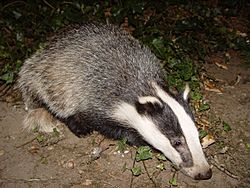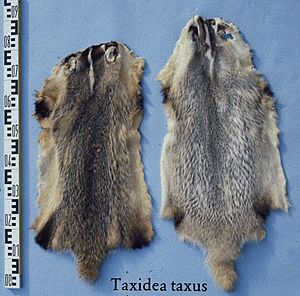Badger facts for kids
Quick facts for kids Badger |
|
|---|---|
 |
|
| European Badger | |
| Scientific classification | |
| Kingdom: | |
| Phylum: | |
| Class: | |
| Order: | |
| Family: | |
| Subfamily: |
Melinae, Mellivorinae, Taxideinae
|
Badgers are short-legged mammals that live in many parts of the world. You can find them in Europe, Africa, North America, and Asia.
Contents
What Do Badgers Look Like?
Badgers have wide bodies and short, strong legs. These legs are perfect for digging! They have long, weasel-like heads with small ears. Their tails can be different lengths, depending on the type of badger.
Most badgers have black faces with white markings. Their bodies are usually grey, with a light-coloured stripe running from their head to their tail. Their legs are dark, and their underbellies are light.
Badgers grow to about 90 centimeters (35 inches) long, including their tail. The European badger is one of the biggest kinds. The American badger, hog badger, and honey badger are a bit smaller. On average, badgers weigh around 9 to 11 kilograms (20 to 24 pounds). Some badgers in Europe and Asia can weigh up to 18 kilograms (40 pounds)!
A male badger is called a boar. A female badger is called a sow. A young badger is called a cub.
Where Do Badgers Live?
Badgers live in many different places around the world. You can find them in North America, Ireland, Britain, and most of Europe.
Some badgers live in specific areas:
- The Javan ferret-badger lives in Indonesia.
- The Bornean ferret-badger lives in Malaysia.
- The honey badger lives in sub-Saharan Africa, the Arabian Desert, parts of the Levant, Turkmenistan, and India.
How Do Badgers Behave?
All badgers live underground. They dig burrows called setts. These setts can be very large, like an underground house!
Some badgers live alone and move from one sett to another. Others live in family groups called cetes. A cete can have anywhere from two to fifteen badgers living together.
Badgers are fast! They can run or gallop at speeds of up to 25–30 kilometers per hour (16–19 mph) for short times. Badgers are only active at night. They are very good at digging. They can dig a hole quickly to escape most predators. They even fill in the hole behind them as they dig!
What Do Badgers Eat?
Badgers eat many different things. The Eurasian badger mainly eats earthworms and insects. They also enjoy grubs and the eggs and young of ground-nesting birds. Sometimes, they eat small mammals, amphibians, reptiles, and other birds. They also munch on roots and fruit.
In Britain, badgers are known to eat hedgehogs. This is why hedgehog rescue groups do not release hedgehogs into areas with many badgers. Badgers can also sometimes eat domestic chickens. They are clever enough to break into chicken coops that even a fox cannot get into. In southern Spain, badgers often eat rabbits.
American badgers are special because they are fossorial carnivores. This means they catch a lot of their food underground by digging. They can tunnel very fast to chase rodents that live in the ground.
The honey badger in Africa eats honey, porcupines, and even venomous snakes. They are known to climb trees to reach honey from bees' nests.
Badgers and Humans
Hunting Badgers
For a long time, people hunted badgers for sport in many countries. The Dachshund dog breed was even created to hunt badgers! A cruel sport called Badger-baiting used to be popular. In this sport, people would make dogs fight badgers. Even though badgers are usually calm, they fight hard when they are trapped.
In England, this sport was banned by the Cruelty to Animals Act 1835 and later by the Protection of Badgers Act 1992. This law made it illegal to kill, hurt, or take a badger. It also made it illegal to disturb a badger's sett without a special permit. The Hunting Act 2004 also stopped fox hunters from blocking badgers' setts during their hunts.
People have also trapped badgers for their fur, called pelts. Badger hair has been used for hundreds of years to make shaving brushes. It's great for this because it holds a lot of water. Today, most badger hair for brushes comes from mainland China. There are farms there that raise badgers for this purpose. In some parts of rural northern China, village groups are allowed to hunt badgers to stop them from damaging crops.
The European badger's fur is also used for trim on some traditional Scottish clothing. The American badger's fur is used for paintbrushes and as trim on some Native American clothes. It has also been used for doll hair.
Badger Population Control
In many European countries, it is against the law to control the badger population. Badgers are protected by the Berne Convention.
In the past, badgers were gassed in Europe during the 1960s and 1970s to control rabies. In the United Kingdom, some badgers were killed to try and stop the spread of a disease called bovine tuberculosis (bTB). This practice was stopped in the 1980s. Later, in 1998, a trial began to see if killing badgers helped. Some studies suggested it was not effective.
Today, some groups want to vaccinate badgers instead of culling them. Wales and Northern Ireland are trying out badger vaccination programs. In 2013, a program to cull badgers started in parts of West Somerset and Gloucestershire. This caused many protests. People argued that it was not good for the badgers, was too expensive, and might not even work.
Badgers as Food
While not common today in the United States or the United Kingdom, badgers were eaten in Britain during World War II and the 1950s. In Russia, eating badger meat is still common. In the Altai Region of Russia, shish kebabs made from badger meat have caused health issues.
In Croatia, badger meat is rarely eaten. When it is, it is usually smoked and dried, or sometimes used in goulash. In France, badger meat was used in dishes like Blaireau au sang and was a common food in the countryside. Badger meat was also eaten in some parts of Spain until recently. In Japan, old stories say that badger is food for humble people.
Badgers as Pets
Badgers can be tamed and kept as pets. However, in the United Kingdom, it is against the law to keep a badger as a pet or to sell one. This is part of the 1992 Protection of Badgers Act.
Images for kids
-
An adult female (sow) American badger
-
Badger, Ratty, Mole, and Mr. Toad from The Wind in the Willows
See also
 In Spanish: Tejón para niños
In Spanish: Tejón para niños




